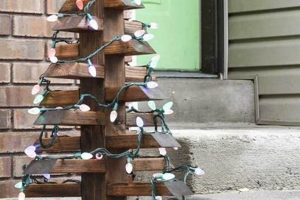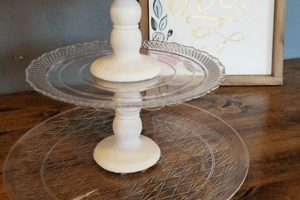The crafting approach involving the creation of a festive holiday centerpiece through individual artistry with clay and related materials represents a popular seasonal activity. This undertaking involves selecting a pre-cast mold or hand-building a conical structure, applying glaze, and firing the piece to achieve a durable, decorative object. An example is a handcrafted, illuminated evergreen replica designed for display during the yuletide season.
This particular form of creative expression fosters personalized ornamentation and offers significant cost savings compared to purchasing pre-made items. Furthermore, it provides an engaging activity for individuals and groups, fostering community and shared experiences. Historically, this type of do-it-yourself crafting has roots in traditional pottery and the home arts movement, gaining popularity during periods emphasizing resourcefulness and individualized creation.
The subsequent sections will elaborate on the materials required, the techniques involved, and the safety precautions necessary for successful completion. Instruction will also encompass design options and considerations for achieving a professional-quality result.
Crafting Ceramic Holiday Centerpieces
The creation of ceramic evergreen replicas requires careful planning and execution. Adherence to best practices is paramount for achieving aesthetically pleasing and structurally sound results.
Tip 1: Mold Preparation is Crucial: Prior to clay application, thoroughly clean and release the mold with appropriate agents. This ensures easy separation of the ceramic piece and minimizes the risk of damage.
Tip 2: Clay Selection Affects Outcome: Choose clay specifically formulated for firing within the constraints of available kiln capabilities. Consider shrinkage rates and the intended aesthetic finish.
Tip 3: Controlled Drying Prevents Cracking: Allow the constructed form to dry slowly and evenly. Drape with plastic sheeting and rotate regularly to prevent uneven moisture loss and subsequent cracking.
Tip 4: Precise Firing Schedule is Essential: Adhere to a firing schedule recommended for the selected clay. Monitor the kiln temperature diligently to achieve proper vitrification and avoid over- or under-firing.
Tip 5: Glaze Application Requires Skill: Apply glaze uniformly in thin, even coats, allowing each coat to dry completely before applying the next. Avoid excessive buildup, which can lead to runs or blisters during firing.
Tip 6: Strategic Lighting Enhances Visual Appeal: Incorporate strategically placed apertures for lighting elements. Consider the placement and intensity of light sources to maximize the aesthetic impact of the finished piece.
Tip 7: Post-Firing Inspection is Mandatory: Thoroughly inspect the fired piece for cracks, glaze imperfections, or structural weaknesses. Address any issues with appropriate repair techniques.
By diligently following these recommendations, hobbyists can enhance the quality and durability of their ceramic holiday creations, resulting in cherished heirlooms for years to come.
The final section will address common problems encountered during this process and offer solutions for troubleshooting and remediation.
1. Clay Selection
Clay selection is a foundational consideration in the creation of ceramic holiday decorations. The type of clay used directly influences the structural integrity, firing characteristics, and final aesthetic of the finished piece. For instance, earthenware clay, while readily available and easily worked, possesses a relatively low firing temperature and higher porosity compared to stoneware or porcelain. This renders earthenware more susceptible to cracking during firing and less durable in the long term. Consequently, the selection of earthenware necessitates careful temperature control and glaze selection to mitigate these risks. Conversely, stoneware clay offers increased durability and resistance to thermal shock, making it suitable for pieces intended for frequent use or display in varying environmental conditions. Porcelain, prized for its translucence and smooth surface, requires specialized firing techniques and equipment due to its high firing temperature and sensitivity to thermal gradients. The choice, therefore, impacts the complexity of the crafting process and the longevity of the resulting ornamentation.
The practical implications of clay choice extend beyond mere structural considerations. The selected clay also dictates the types of glazes and surface treatments that can be effectively applied. Earthenware clays, for example, necessitate the use of low-fire glazes, while stoneware and porcelain clays can accommodate a wider range of glaze types, including high-fire options that offer greater durability and color vibrancy. Furthermore, the shrinkage rate of the chosen clay must be carefully considered, as it affects the fit and adherence of glazes. A mismatch in shrinkage rates can result in glaze crazing or shivering, compromising the visual appeal and structural integrity of the piece. Some clays are also more amenable to intricate detailing and carving, allowing for greater artistic expression. Understanding these nuances allows the artisan to select the clay best suited to the intended design and desired outcome.
In summary, clay selection represents a critical juncture in crafting ceramic holiday ornaments. It directly influences the physical properties, firing requirements, and aesthetic possibilities of the finished piece. The challenges associated with inappropriate clay selection, such as cracking, glaze defects, and reduced durability, underscore the importance of informed decision-making in this initial stage. Connecting the proper selection of clay to the desired final product facilitates a more predictable and satisfying outcome, aligning with the broader goals of crafting durable and visually appealing holiday adornments.
2. Mold Preparation
In the context of creating ceramic holiday decorations, specifically those in the form of evergreen replicas, mold preparation constitutes a critical step influencing the final product’s structural integrity and aesthetic quality. Proper preparation ensures clean release, accurate replication of design details, and minimization of defects.
- Cleaning and Inspection
The mold must be thoroughly cleaned of any residual clay or release agents from previous castings. Accumulated debris can distort the surface texture and prevent uniform clay application. Visual inspection for cracks, chips, or other imperfections is necessary; these flaws can transfer to the ceramic piece, compromising its structural integrity and aesthetic value. For example, a hairline crack in the mold can create a corresponding ridge on the tree’s surface, detracting from its overall appearance.
- Application of Release Agent
A release agent, typically a soap-based solution or commercial mold release compound, facilitates the separation of the cast ceramic form from the mold. The agent must be applied uniformly and sparingly; excessive application can lead to surface blemishes or trapped moisture, while insufficient application results in the clay adhering to the mold, risking damage upon removal. A common example involves using too much petroleum-based release agent, leading to a greasy residue that interferes with glaze adhesion.
- Seam Alignment and Reinforcement
Multi-part molds, frequently used for complex designs, require precise alignment to prevent visible seam lines on the finished piece. Proper alignment often involves securing the mold sections with straps or clamps. Reinforcement may be necessary to prevent mold distortion under the pressure of the wet clay. Misaligned seams result in noticeable ridges on the ceramic Christmas tree, requiring time-consuming post-firing cleanup. A case in point is a mold lacking sufficient external support, leading to bulging and warping during casting.
Effective mold preparation is thus intrinsically linked to the successful creation of a ceramic holiday centerpiece. By addressing cleaning, release agent application, and mold alignment, artisans can significantly improve the quality and reduce the likelihood of defects, resulting in a more visually appealing and structurally sound decorative object. This meticulous attention to detail in the initial stages ultimately enhances the overall artistic and functional value of the completed creation.
3. Firing Schedule
The firing schedule constitutes a critical determinant of success in crafting ceramic holiday centerpieces. This meticulously planned sequence of temperature adjustments and holding periods directly impacts the structural integrity, glaze adherence, and overall aesthetic appeal of the finished product. A deficient firing schedule can induce irreversible damage, including cracking, warping, or glaze defects, rendering the handmade object unusable. For example, a ceramic evergreen replica fired too rapidly may experience thermal shock, resulting in extensive cracking throughout the clay body. Conversely, insufficient firing prevents adequate vitrification, leading to a weak and porous structure prone to moisture absorption and subsequent degradation.
Practical application necessitates careful calibration of the firing schedule to the specific properties of the clay and glaze being used. Clay types exhibit varying shrinkage rates and vitrification temperatures, each requiring a unique thermal profile. Similarly, glazes have specific melting points and maturation ranges, which must be precisely matched to the firing schedule to achieve the desired color, texture, and durability. Consider the situation where a low-fire glaze is applied to a stoneware clay body and fired to stoneware temperatures. The glaze would likely over-fire, resulting in runs, blisters, or discoloration, while the stoneware clay might warp. The complexity increases when incorporating multiple glaze layers, as each layer can influence the firing behavior of the others. In creating a ceramic evergreen replica, green base glaze may require a precise heat treatment so as not to bleed into applied snow effects.
In summary, the firing schedule is not merely a procedural step but an integral component influencing the longevity and beauty of ceramic holiday decorations. A well-executed firing schedule ensures proper vitrification, glaze maturation, and overall structural stability. The challenges inherent in selecting and implementing the optimal schedule underscore the importance of experience, knowledge, and meticulous attention to detail. Understanding the complex interplay between clay, glaze, and temperature allows for consistent results and minimizes the risk of costly failures, ultimately transforming raw materials into cherished holiday heirlooms. Moreover, it is important to understand potential energy consumption and ways to optimize energy use when considering a firing schedule.
4. Glaze Application
Glaze application represents a critical phase in the creation of ceramic holiday decorations, directly influencing the aesthetic appeal, durability, and functional suitability of the finished piece. It involves applying a vitreous coating to the fired clay body, transforming its surface properties and enhancing its visual characteristics.
- Surface Protection and Waterproofing
Glaze provides a protective layer that seals the porous ceramic surface, preventing water absorption and staining. This waterproofing is particularly relevant for ceramic Christmas trees intended for display outdoors or in humid environments, as it prevents moisture-related damage, such as cracking or mold growth. A tree without adequate glazing may degrade rapidly when exposed to the elements.
- Aesthetic Enhancement
Glazes offer a wide range of colors, textures, and finishes, allowing for customization and artistic expression. The choice of glaze can dramatically alter the appearance of a ceramic Christmas tree, from traditional glossy greens and reds to more contemporary matte or iridescent effects. For instance, a textured glaze can simulate the appearance of snow-covered branches, while a metallic glaze can add a touch of elegance.
- Adherence and Firing Considerations
The successful application of glaze hinges on proper adherence to the clay surface and compatibility with the firing schedule. The glaze must be applied uniformly in thin, even layers to prevent running, bubbling, or crazing during firing. The firing temperature must be precisely controlled to ensure that the glaze melts and fuses properly to the clay body. Incompatible glazes or improper firing can result in surface defects, compromising the aesthetic and structural integrity of the ceramic Christmas tree.
- Safety and Functionality
Certain glazes are formulated to be food-safe and lead-free, ensuring that the finished ceramic Christmas tree is safe for use near food items or in households with children. Proper glazing also contributes to the overall durability of the piece, making it resistant to scratches, chips, and fading. It is important to select glazes that meet safety standards and are appropriate for the intended use of the ceramic holiday decoration.
The multifaceted nature of glaze application underscores its importance in the creation of high-quality ceramic holiday decorations. Proper glaze selection, application technique, and firing management are essential for achieving both aesthetic and functional success, transforming a simple clay form into a cherished heirloom.
5. Wiring Techniques
The integration of electrical wiring is a pivotal stage in the creation of illuminated ceramic holiday centerpieces. This process transforms a static decorative object into a dynamic focal point through strategic placement and secure connection of lighting elements. The efficacy of the wiring dictates the overall aesthetic impact and, critically, the safety of the final product.
- Aperture Preparation
Prior to wiring, the ceramic form requires strategically placed apertures to accommodate light sources. These openings must be properly sized and positioned to ensure adequate illumination while maintaining structural integrity. Improperly sized apertures can lead to light leakage, compromising the aesthetic appeal, or structural weakness, increasing the risk of breakage. An example of effective aperture planning involves creating smaller openings for individual lights to simulate stars, contrasting with larger openings for a central bulb that provides ambient illumination.
- Wiring Harness Construction
The wiring harness, comprised of electrical wire, sockets, and a power cord, constitutes the electrical infrastructure of the illuminated centerpiece. Constructing this harness requires adherence to electrical safety standards, including proper wire gauge selection and secure connections. The use of undersized wire can lead to overheating and fire hazards, while loose connections can result in intermittent lighting or electrical shorts. A well-constructed harness incorporates strain relief mechanisms to prevent damage to the wiring due to tension or movement.
- Light Source Selection and Installation
The choice of light source, ranging from incandescent bulbs to LED arrays, significantly impacts the illumination characteristics and energy efficiency of the ceramic holiday decoration. LED lights, known for their low energy consumption and long lifespan, are increasingly favored over traditional incandescent bulbs. Secure installation of the light source within the prepared apertures is essential to prevent movement and potential damage to the wiring or ceramic form. The placement and type of lights significantly affects the glow the christmas tree can have.
- Safety Considerations and Testing
Electrical safety is paramount throughout the wiring process. All connections must be properly insulated to prevent electrical shock, and the completed wiring must be tested for continuity and short circuits before final assembly. The use of a ground fault circuit interrupter (GFCI) outlet is recommended to provide additional protection against electrical hazards. A final safety inspection should be performed to ensure compliance with electrical codes and standards, safeguarding against potential hazards.
Effective application of wiring techniques elevates the ceramic holiday centerpiece from a static decoration to a dynamic and captivating element. Precision in aperture preparation, harness construction, light source selection, and adherence to safety protocols ensures not only a visually appealing outcome but also a safe and reliable illuminated display for years to come.
6. Painting Methods
The application of paint, including underglazes, stains, or acrylics, is a crucial determinant of the aesthetic appeal and detail definition in the creation of ceramic holiday centerpieces. The chosen painting method dictates the level of precision achievable, the color saturation, and the overall visual impact of the decorative object. In the context of a ceramic evergreen replica, painting techniques allow for the simulation of snow-covered branches, the addition of intricate ornament details, or the creation of a vintage, distressed appearance. Improper technique can result in uneven color distribution, loss of detail, or a visually unappealing, amateurish finish. For example, a poorly executed dry-brushing technique intended to mimic snow accumulation can result in a streaky, unnatural appearance that detracts from the overall realism of the piece.
The selection of painting method must align with the desired aesthetic outcome and the properties of the ceramic surface. Underglazes, applied to greenware or bisqueware, require a subsequent glaze firing to achieve their final color and surface characteristics. Stains, typically applied to bisqueware, offer a greater degree of control over color intensity and detail definition but may lack the durability of fired glazes. Acrylic paints, applied to fired ceramic surfaces, provide a convenient and versatile option for adding intricate details or color accents, but they lack the permanence of fired finishes and may be susceptible to scratching or fading. Consider the application of a delicate gold luster to simulate garland; its success relies on precise brushwork and meticulous firing control. The correct painting choice is vital for detail and depth.
In summation, the proficiency in various painting methods is essential for achieving a professional-quality ceramic holiday centerpiece. The cause-and-effect relationship between painting technique and visual outcome underscores the importance of careful planning and execution. Overcoming the challenges of selecting appropriate painting media and mastering the relevant techniques ensures that the finished piece not only meets aesthetic expectations but also contributes to the lasting appeal of a cherished holiday decoration.
7. Light Placement
Light placement is integral to the aesthetic success of a handcrafted ceramic evergreen replica. The strategic positioning of light sources within the form dictates the overall illumination pattern and accentuates specific design elements. Ineffective light placement can result in uneven brightness, obscured details, or a generally unappealing visual effect. Conversely, thoughtful light arrangement enhances the tree’s three-dimensional form, accentuates glaze textures, and contributes to a warm, inviting ambiance. For example, placing a concentrated light source near the base of the ceramic form can create a dramatic up-lighting effect, emphasizing the conical shape and drawing attention to any decorative elements near the bottom.
The selection of bulb type influences the optimal light placement strategy. Incandescent bulbs, characterized by their warm color temperature and omnidirectional light emission, often require diffusion to prevent harsh shadows. This can be achieved by positioning the bulb behind a translucent ceramic panel or using a frosted bulb. Light Emitting Diodes (LEDs), available in a range of color temperatures and beam angles, offer greater control over light distribution and can be strategically placed to highlight specific features. A string of miniature LED lights woven through the branches can simulate the appearance of twinkling ornaments, while a single, focused LED spotlight can highlight a particular decorative element, such as a hand-painted star. An artisan can use smaller bulbs on the bottom and larger brighter bulbs on the higher tiers of the tree to create a more realistic look as well. This will take careful planning and placement during creation.
In summary, the placement of lighting within a ceramic holiday centerpiece is not merely a functional consideration but a critical design element that significantly impacts the visual appeal of the finished product. Careful consideration of light source characteristics, aperture placement, and diffusion techniques is essential for achieving a balanced and aesthetically pleasing illumination pattern. Challenges include balancing the need for adequate brightness with the avoidance of glare and ensuring the structural integrity of the ceramic form while accommodating wiring and light sources. These considerations are vital when creating ceramic holiday decorations that enhance the festive ambiance of any space.
Frequently Asked Questions Regarding Ceramic Holiday Centerpiece Creation
This section addresses common inquiries concerning the crafting process for ceramic holiday evergreens. It provides concise and informative answers based on best practices and established techniques.
Question 1: What is the optimal type of clay for constructing a ceramic Christmas tree?
The selection of clay should align with firing capabilities and desired aesthetic. Stoneware clay offers durability and is suitable for high-fire glazes. Earthenware, while more accessible, requires lower firing temperatures and careful glaze selection.
Question 2: How does the application of a release agent impact the final ceramic piece?
A release agent facilitates separation from the mold, preventing damage. Uniform application is crucial; excessive use can lead to surface defects, while insufficient application risks adhesion and breakage.
Question 3: What considerations are paramount when establishing a firing schedule?
The firing schedule must correspond to the clay and glaze properties. Inadequate temperature control can result in cracking, warping, or glaze imperfections, compromising the structural integrity and aesthetic quality.
Question 4: What are the implications of improper glaze application techniques?
Uneven glaze application can cause running, bubbling, or crazing during firing. Precise application in thin, even layers is essential for achieving a smooth, durable, and visually appealing finish.
Question 5: What safety measures should be observed when integrating electrical wiring into a ceramic Christmas tree?
All wiring connections must be properly insulated to prevent electrical shock. The use of appropriate wire gauge and a ground fault circuit interrupter (GFCI) outlet is recommended for enhanced safety.
Question 6: How does light placement influence the overall aesthetic of an illuminated ceramic evergreen replica?
Strategic light placement accentuates specific design elements and creates a desired illumination pattern. Thoughtful arrangement enhances the three-dimensional form and contributes to a warm, inviting ambiance.
Mastery of these key considerations enhances the probability of success. Understanding these elements is imperative for crafting durable and visually appealing holiday adornments.
The subsequent sections will delve into specific troubleshooting strategies for common issues encountered during the crafting process.
Conclusion
The comprehensive exploration of ceramic christmas tree diy has elucidated the multifaceted nature of this craft, encompassing clay selection, mold preparation, firing schedules, glazing techniques, wiring protocols, and paint application. The meticulous execution of each stage dictates the structural integrity, aesthetic appeal, and functional safety of the final product. A deficient approach in any one area can compromise the overall quality and longevity of the handmade artifact.
As demonstrated, the successful realization of ceramic christmas tree diy projects necessitates not only artistic skill but also a thorough understanding of ceramic principles and meticulous attention to detail. Mastering these elements ensures the creation of cherished holiday centerpieces and promotes a deeper appreciation for the fusion of artistry and technical expertise. The application of these principles will help crafters achieve stunning results.







